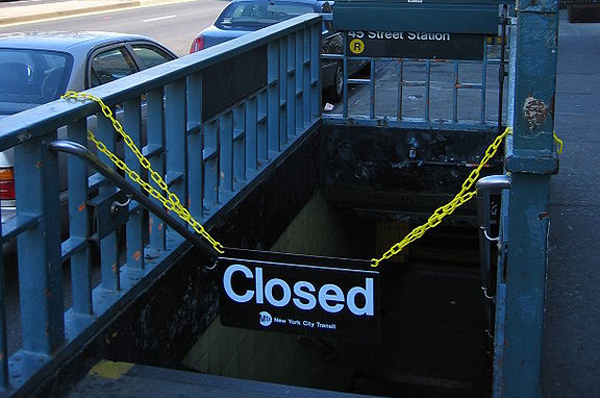
Photo by: AutisticPsycho2
Of the 468 subway stations in New York City only 97 are accessible, according to the MTA.
This is a sidebar to our story about disability advocates’ complaints about the Bloomberg administration. Read the main article here.
It is not as if Mayor Bloomberg is uniquely insensitive to the needs of the disabled. Disabled New Yorkers face inaccessible buildings and subpar services from plenty of entities not under mayoral control. The MTA, for example, has failed to update its subway infrastructure to make the system accessible. Of the 468 subway stations in New York City only 97 are accessible, according to the MTA. Even these stations can be dangerous for wheelchair-users. As NY1 reported in July, passengers in wheelchairs frequently get stuck between the subway car and the platform at nominally accessible stations, because the vertical gap between the platform and train is often more than the legally allowable two inches.
The MTA says that it has provided a raised boarding area that aligns with a door and is near the conductor at every accessible station. But wheelchair users say that the boarding areas do not always match up from station to station, so that if you get on at one, you will be in the wrong place when get off elsewhere. Bus drivers are also wont to load too far away from the curb, making the wheelchair ramp steep and unusable.
Currently, because of the dearth of accessible subways, New Yorkers with disabilities rely on Access-A-Ride, a van service, for interborough transportation. It is widely criticized for being economically inefficient and offering inadequate service. At a 2009 City Council hearing, according to the website Transportation Access, “Access-A-Ride customers and advocates told stories of missing safety straps, lengthy trips, service delays and sagging lifts.”
Unlike a taxi, which can be hailed on the street, Access-A-Ride requires making an appointment a full day in advance. And it costs a small fortune. The MTA spends an average of $66 per trip on Access-A-Ride and nearly half a billion dollars per year in total. As The Daily News reported in April, the MTA considered a plan to make bus and subway fares free for riders with disabilities to lure them out of Access-A-Ride. As the News noted, “Access-a-Ride service is so terrible that, given the slightest monetary benefit, even truly disabled people will mount herculean struggles to avoid it.” Another obvious solution, though, would be to allow the disabled to take taxis, for which a typical fare is usually far below $66, and have the MTA pay for it. That, though, would require accessible cabs.
The MTA argues that upgrading New York’s ancient subway system necessarily takes many decades, but that new stations are always accessible, as are all buses. “The task of creating an accessible subway system is neither a quick nor easy one,” writes MTA spokesman Charles Seaton in an email. “It is not as simple as just adding an elevator. While all newly-built subway stations are ADA compliant, creating an accessible station within the existing system is usually done in conjunction with a complete station rehabilitation as it often requires the relocation of components, stairways and utilities.”
And Seaton says they are making progress on Access-A-Ride service. “The complaint ratio for Access-A-Ride and each category of complaints have significantly decreased since 2009,” notes Seaton.
But advocates for the disabled also slam Access-A-Ride for shutting down hours before the rest of the MTA ahead of Sandy, leaving disabled people with few options for getting out of threatened neighborhoods.
The MTA doesn’t deny shutting down Access-A-Ride well in advance of the subway shutdown, which began at 7 p.m. Writes Seaton: “We provided outgoing rides on Sunday [October 29, the day before Sandy hit] until noon and return rides with pick-up times no later than 5 p.m.” Seaton added that unlike fixed-route transit, “Access-A-Ride, must be concerned with returning our customers home so we allowed time to accomplish this while also meeting the shutdown time.” He continues: “We accepted same-day trip requests for medical necessity purposes and evacuations from Zone A up to shutdown. Following the storm, we resumed bookings after a complete assessment, but initially excluded Zone A.”








